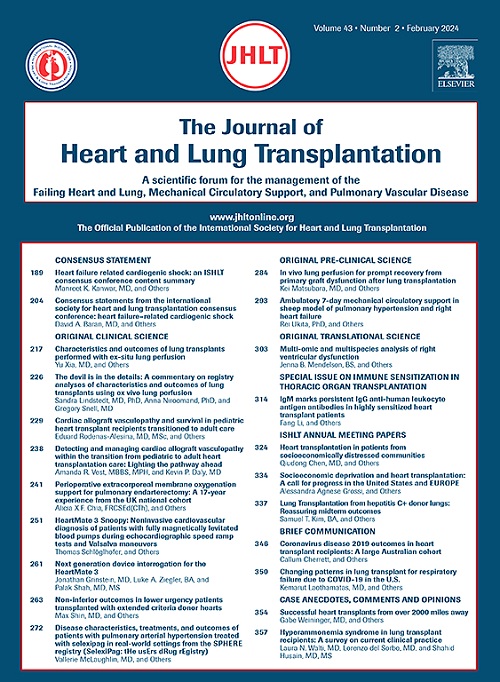在肺移植过程中,通过 Pfa- 200 检测到 ecmo 在原发性止血方面产生了非常快速的变化:一项观察性研究。
IF 6.4
1区 医学
Q1 CARDIAC & CARDIOVASCULAR SYSTEMS
引用次数: 0
摘要
背景:原发性止血的病理变化是体外膜氧合(ECMO)支持的常见并发症。目的:本研究旨在使用 PFA-200®、ROTEM® 血小板和冯-维勒布兰德因子(von Willebrand factor,vWF)分析法,描述短期 ECMO 支持下患者原发性止血的病理变化及其随时间的发展:方法: 在使用术中静脉-动脉 ECMO 支持进行肺移植手术的患者中,使用以下检测方法对血液样本进行分析:在 ECMO 支持之前、期间和之后,使用 PFA-200®、ROTEM® 血小板测试、vWF 抗原、利斯托西汀辅助因子(RCo)和胶原结合蛋白(CB)对血液样本进行分析:对 32 名患者的血液样本进行了分析。所有三项 PFA-200® 检测(COL/EPI、COL/ADP 和 COL/P2Y)均显示 ECMO 支持期间病情明显恶化,但在 ECMO 停止后迅速恢复(P0.05):结论:短期 ECMO 支持会诱发原发性止血病变。结论:短期 ECMO 支持会诱发原发性止血病变,这种病变会在启动后立即出现,但在 ECMO 停止后会迅速恢复,并可通过 PFA-200® 检测到。尽管如 ROTEM® 血小板检测结果所示,ECMO 停止后血小板功能持续失调,但 vWF 抗原水平的升高可能是 PFA-200® 检测到的原发性止血正常结果的原因。本文章由计算机程序翻译,如有差异,请以英文原文为准。
ECMO produces very rapid changes in primary hemostasis detected by PFA-200 during lung transplantation: An observational study
Background
The pathology of primary hemostasis is a common complication of extracorporeal membrane oxygenation (ECMO) support. Scientific data describing its changes in patients on short-term ECMO support and the ability and speed of the restoration of its functions are limited.
Aims
The aim of this study was to describe the pathology of primary hemostasis induced by short-term ECMO support and its development over time using PFA-200, ROTEM platelet, and von Willebrand factor (vWF) analyses.
Methods
In patients undergoing lung transplantation surgery using intraoperative veno-arterial ECMO support, blood samples were analyzed using the following tests: PFA-200, ROTEM platelet tests, vWF antigen, ristocetin cofactor (RCo), and collagen-binding protein (CB) before, during, and after ECMO support.
Results
Blood samples from 32 patients were analyzed. All 3 PFA-200 tests (COL/EPI, COL/ADP, and COL/P2Y) showed significant deterioration during ECMO support with rapid restoration after ECMO cessation (p < 0.05), suggesting an ECMO-induced primary hemostasis disorder. A significant increase of vWF antigen after ECMO cessation (p < 0.05) was found with an increase of RCo and CB levels, although it was not significant (p > 0.05).
Conclusions
Short-term ECMO support induces primary hemostasis pathology. It occurs immediately after initiation but is rapidly restored after ECMO cessation, which is detectable by PFA-200. Despite there being persistent platelet dysfunction after ECMO cessation, as seen with the ROTEM platelet results, the increased levels of vWF antigen might explain the normal results of primary hemostasis detected by PFA-200.
求助全文
通过发布文献求助,成功后即可免费获取论文全文。
去求助
来源期刊
CiteScore
10.10
自引率
6.70%
发文量
1667
审稿时长
69 days
期刊介绍:
The Journal of Heart and Lung Transplantation, the official publication of the International Society for Heart and Lung Transplantation, brings readers essential scholarly and timely information in the field of cardio-pulmonary transplantation, mechanical and biological support of the failing heart, advanced lung disease (including pulmonary vascular disease) and cell replacement therapy. Importantly, the journal also serves as a medium of communication of pre-clinical sciences in all these rapidly expanding areas.

 求助内容:
求助内容: 应助结果提醒方式:
应助结果提醒方式:


